Comprehensive Evaluation Report: Marram-Ngala Ganbu Health Program
VerifiedAdded on 2022/10/11
|14
|3123
|7
Report
AI Summary
This report evaluates the Marram-Ngala Ganbu program, a health promotion initiative aimed at supporting Koori youth and families involved in child protection proceedings and the justice system. The program, associated with Court Services Victoria (CSV), seeks to improve outcomes for Koori children, encourage family participation, and provide cultural support within legal and healthcare contexts. The evaluation includes a review of the program's strategies, which prioritize the protection and development of at-risk Koori youth. A literature review highlights the challenges faced by the Aboriginal population, including issues of miscommunication, discrimination, and disproportionate involvement in the justice system. The report also outlines an evaluation strategy that employs both quantitative and qualitative methods, focusing on key research questions regarding the program's impact, stakeholder experiences, and potential for improvement. Data collection methods include surveys, questionnaires, and analysis of court documents. The goal is to assess the program's effectiveness, identify areas for enhancement, and contribute to the broader effort of improving the health and well-being of Indigenous Australians.
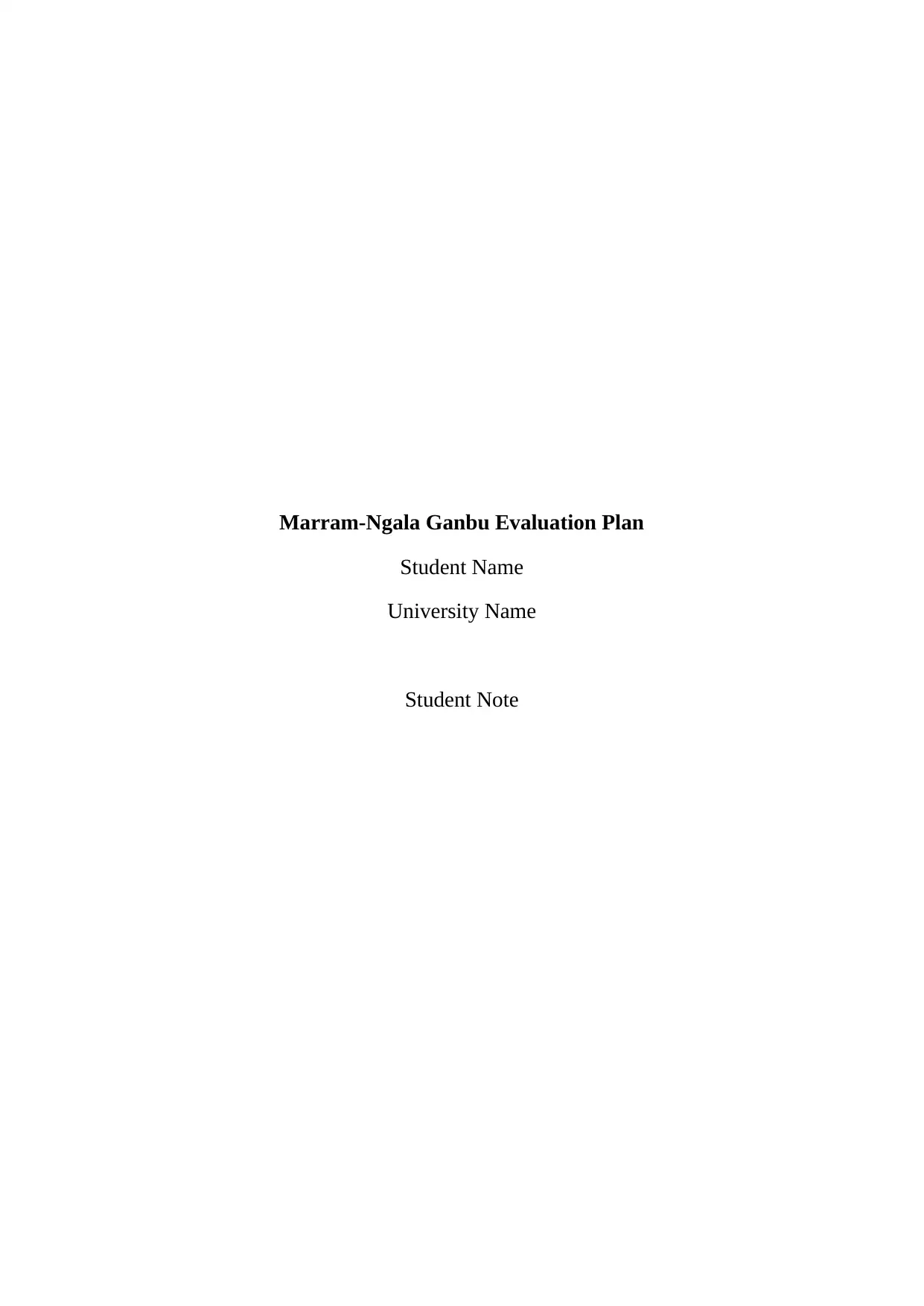
Marram-Ngala Ganbu Evaluation Plan
Student Name
University Name
Student Note
Student Name
University Name
Student Note
Paraphrase This Document
Need a fresh take? Get an instant paraphrase of this document with our AI Paraphraser
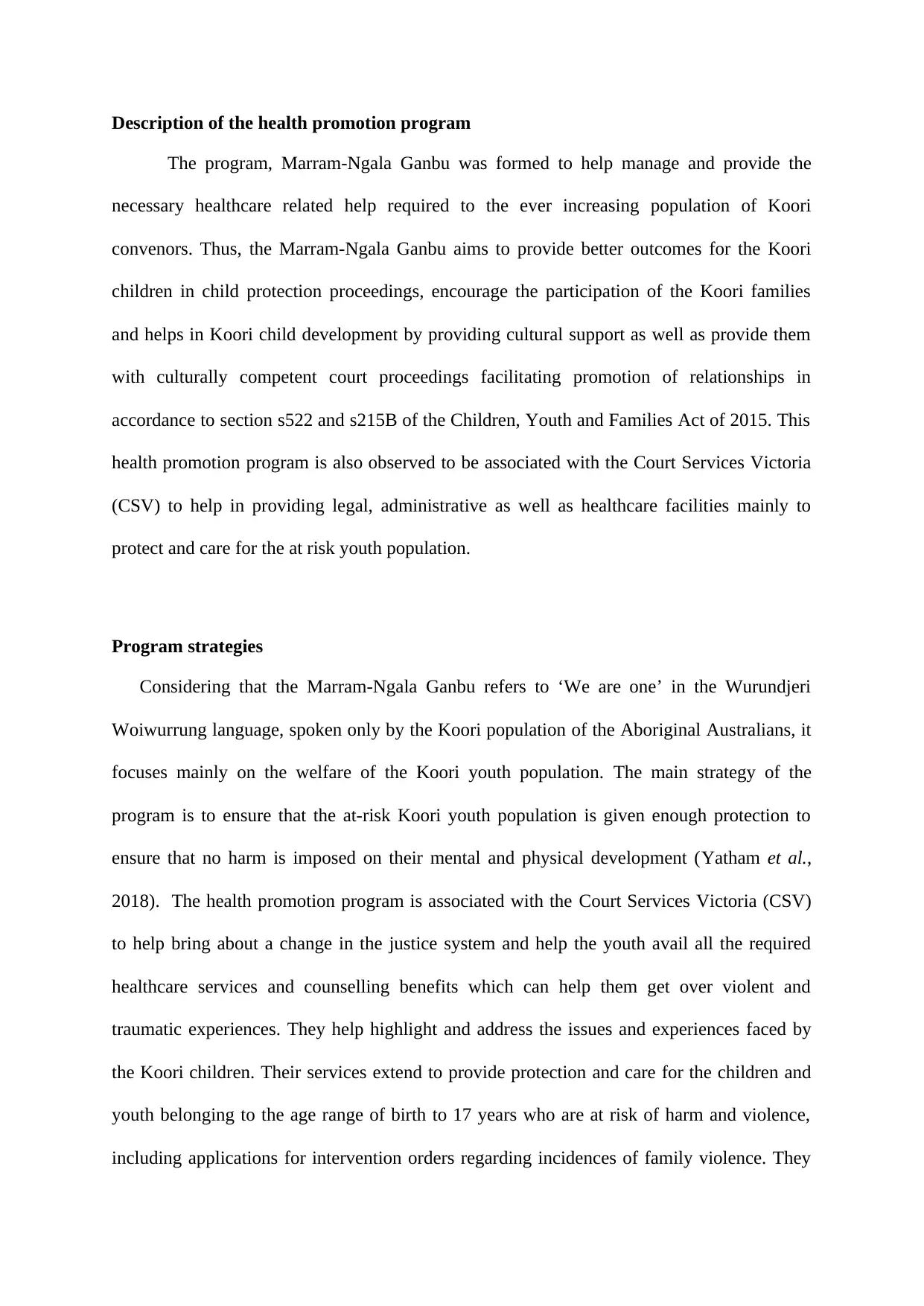
Description of the health promotion program
The program, Marram-Ngala Ganbu was formed to help manage and provide the
necessary healthcare related help required to the ever increasing population of Koori
convenors. Thus, the Marram-Ngala Ganbu aims to provide better outcomes for the Koori
children in child protection proceedings, encourage the participation of the Koori families
and helps in Koori child development by providing cultural support as well as provide them
with culturally competent court proceedings facilitating promotion of relationships in
accordance to section s522 and s215B of the Children, Youth and Families Act of 2015. This
health promotion program is also observed to be associated with the Court Services Victoria
(CSV) to help in providing legal, administrative as well as healthcare facilities mainly to
protect and care for the at risk youth population.
Program strategies
Considering that the Marram-Ngala Ganbu refers to ‘We are one’ in the Wurundjeri
Woiwurrung language, spoken only by the Koori population of the Aboriginal Australians, it
focuses mainly on the welfare of the Koori youth population. The main strategy of the
program is to ensure that the at-risk Koori youth population is given enough protection to
ensure that no harm is imposed on their mental and physical development (Yatham et al.,
2018). The health promotion program is associated with the Court Services Victoria (CSV)
to help bring about a change in the justice system and help the youth avail all the required
healthcare services and counselling benefits which can help them get over violent and
traumatic experiences. They help highlight and address the issues and experiences faced by
the Koori children. Their services extend to provide protection and care for the children and
youth belonging to the age range of birth to 17 years who are at risk of harm and violence,
including applications for intervention orders regarding incidences of family violence. They
The program, Marram-Ngala Ganbu was formed to help manage and provide the
necessary healthcare related help required to the ever increasing population of Koori
convenors. Thus, the Marram-Ngala Ganbu aims to provide better outcomes for the Koori
children in child protection proceedings, encourage the participation of the Koori families
and helps in Koori child development by providing cultural support as well as provide them
with culturally competent court proceedings facilitating promotion of relationships in
accordance to section s522 and s215B of the Children, Youth and Families Act of 2015. This
health promotion program is also observed to be associated with the Court Services Victoria
(CSV) to help in providing legal, administrative as well as healthcare facilities mainly to
protect and care for the at risk youth population.
Program strategies
Considering that the Marram-Ngala Ganbu refers to ‘We are one’ in the Wurundjeri
Woiwurrung language, spoken only by the Koori population of the Aboriginal Australians, it
focuses mainly on the welfare of the Koori youth population. The main strategy of the
program is to ensure that the at-risk Koori youth population is given enough protection to
ensure that no harm is imposed on their mental and physical development (Yatham et al.,
2018). The health promotion program is associated with the Court Services Victoria (CSV)
to help bring about a change in the justice system and help the youth avail all the required
healthcare services and counselling benefits which can help them get over violent and
traumatic experiences. They help highlight and address the issues and experiences faced by
the Koori children. Their services extend to provide protection and care for the children and
youth belonging to the age range of birth to 17 years who are at risk of harm and violence,
including applications for intervention orders regarding incidences of family violence. They
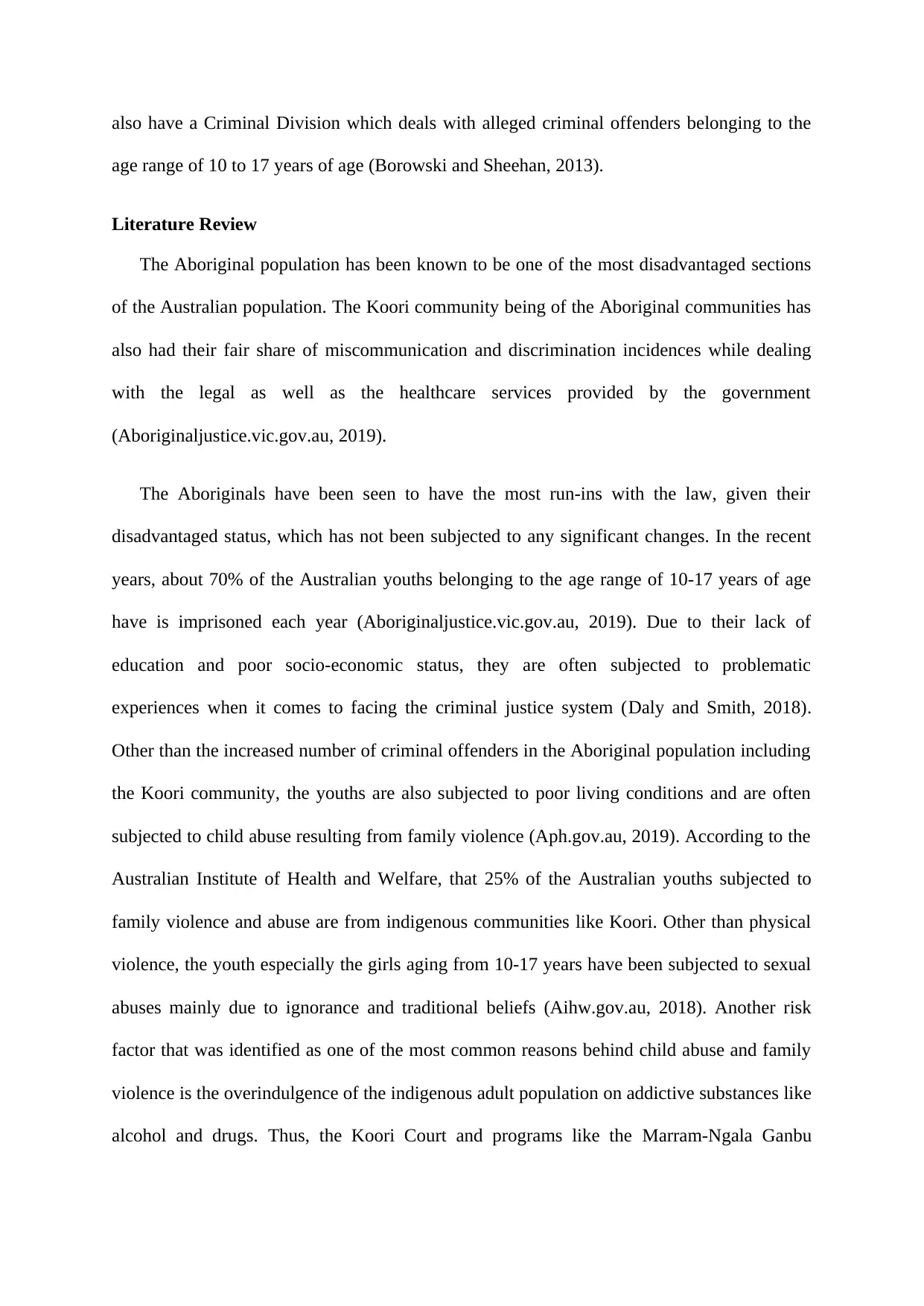
also have a Criminal Division which deals with alleged criminal offenders belonging to the
age range of 10 to 17 years of age (Borowski and Sheehan, 2013).
Literature Review
The Aboriginal population has been known to be one of the most disadvantaged sections
of the Australian population. The Koori community being of the Aboriginal communities has
also had their fair share of miscommunication and discrimination incidences while dealing
with the legal as well as the healthcare services provided by the government
(Aboriginaljustice.vic.gov.au, 2019).
The Aboriginals have been seen to have the most run-ins with the law, given their
disadvantaged status, which has not been subjected to any significant changes. In the recent
years, about 70% of the Australian youths belonging to the age range of 10-17 years of age
have is imprisoned each year (Aboriginaljustice.vic.gov.au, 2019). Due to their lack of
education and poor socio-economic status, they are often subjected to problematic
experiences when it comes to facing the criminal justice system (Daly and Smith, 2018).
Other than the increased number of criminal offenders in the Aboriginal population including
the Koori community, the youths are also subjected to poor living conditions and are often
subjected to child abuse resulting from family violence (Aph.gov.au, 2019). According to the
Australian Institute of Health and Welfare, that 25% of the Australian youths subjected to
family violence and abuse are from indigenous communities like Koori. Other than physical
violence, the youth especially the girls aging from 10-17 years have been subjected to sexual
abuses mainly due to ignorance and traditional beliefs (Aihw.gov.au, 2018). Another risk
factor that was identified as one of the most common reasons behind child abuse and family
violence is the overindulgence of the indigenous adult population on addictive substances like
alcohol and drugs. Thus, the Koori Court and programs like the Marram-Ngala Ganbu
age range of 10 to 17 years of age (Borowski and Sheehan, 2013).
Literature Review
The Aboriginal population has been known to be one of the most disadvantaged sections
of the Australian population. The Koori community being of the Aboriginal communities has
also had their fair share of miscommunication and discrimination incidences while dealing
with the legal as well as the healthcare services provided by the government
(Aboriginaljustice.vic.gov.au, 2019).
The Aboriginals have been seen to have the most run-ins with the law, given their
disadvantaged status, which has not been subjected to any significant changes. In the recent
years, about 70% of the Australian youths belonging to the age range of 10-17 years of age
have is imprisoned each year (Aboriginaljustice.vic.gov.au, 2019). Due to their lack of
education and poor socio-economic status, they are often subjected to problematic
experiences when it comes to facing the criminal justice system (Daly and Smith, 2018).
Other than the increased number of criminal offenders in the Aboriginal population including
the Koori community, the youths are also subjected to poor living conditions and are often
subjected to child abuse resulting from family violence (Aph.gov.au, 2019). According to the
Australian Institute of Health and Welfare, that 25% of the Australian youths subjected to
family violence and abuse are from indigenous communities like Koori. Other than physical
violence, the youth especially the girls aging from 10-17 years have been subjected to sexual
abuses mainly due to ignorance and traditional beliefs (Aihw.gov.au, 2018). Another risk
factor that was identified as one of the most common reasons behind child abuse and family
violence is the overindulgence of the indigenous adult population on addictive substances like
alcohol and drugs. Thus, the Koori Court and programs like the Marram-Ngala Ganbu
⊘ This is a preview!⊘
Do you want full access?
Subscribe today to unlock all pages.

Trusted by 1+ million students worldwide
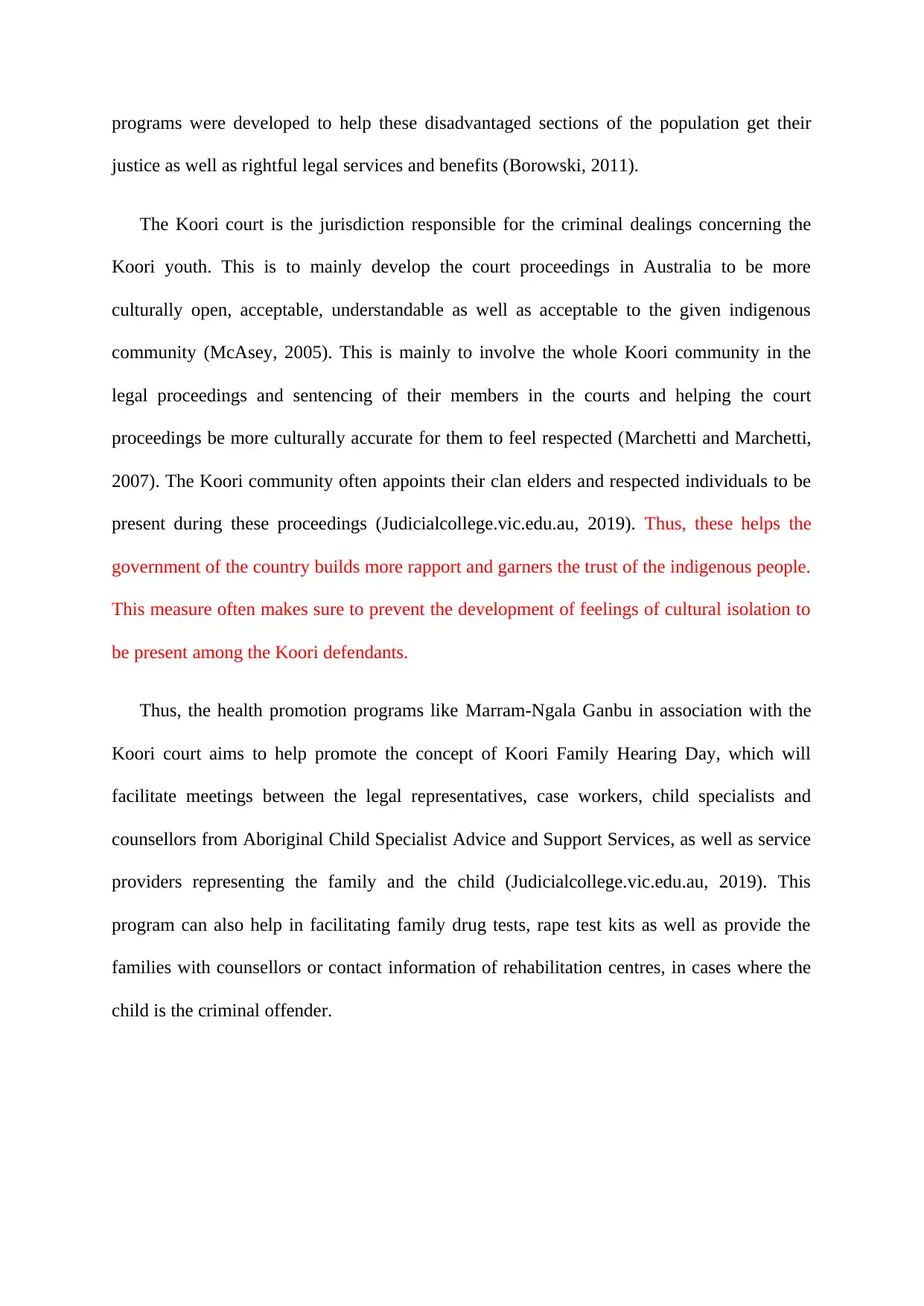
programs were developed to help these disadvantaged sections of the population get their
justice as well as rightful legal services and benefits (Borowski, 2011).
The Koori court is the jurisdiction responsible for the criminal dealings concerning the
Koori youth. This is to mainly develop the court proceedings in Australia to be more
culturally open, acceptable, understandable as well as acceptable to the given indigenous
community (McAsey, 2005). This is mainly to involve the whole Koori community in the
legal proceedings and sentencing of their members in the courts and helping the court
proceedings be more culturally accurate for them to feel respected (Marchetti and Marchetti,
2007). The Koori community often appoints their clan elders and respected individuals to be
present during these proceedings (Judicialcollege.vic.edu.au, 2019). Thus, these helps the
government of the country builds more rapport and garners the trust of the indigenous people.
This measure often makes sure to prevent the development of feelings of cultural isolation to
be present among the Koori defendants.
Thus, the health promotion programs like Marram-Ngala Ganbu in association with the
Koori court aims to help promote the concept of Koori Family Hearing Day, which will
facilitate meetings between the legal representatives, case workers, child specialists and
counsellors from Aboriginal Child Specialist Advice and Support Services, as well as service
providers representing the family and the child (Judicialcollege.vic.edu.au, 2019). This
program can also help in facilitating family drug tests, rape test kits as well as provide the
families with counsellors or contact information of rehabilitation centres, in cases where the
child is the criminal offender.
justice as well as rightful legal services and benefits (Borowski, 2011).
The Koori court is the jurisdiction responsible for the criminal dealings concerning the
Koori youth. This is to mainly develop the court proceedings in Australia to be more
culturally open, acceptable, understandable as well as acceptable to the given indigenous
community (McAsey, 2005). This is mainly to involve the whole Koori community in the
legal proceedings and sentencing of their members in the courts and helping the court
proceedings be more culturally accurate for them to feel respected (Marchetti and Marchetti,
2007). The Koori community often appoints their clan elders and respected individuals to be
present during these proceedings (Judicialcollege.vic.edu.au, 2019). Thus, these helps the
government of the country builds more rapport and garners the trust of the indigenous people.
This measure often makes sure to prevent the development of feelings of cultural isolation to
be present among the Koori defendants.
Thus, the health promotion programs like Marram-Ngala Ganbu in association with the
Koori court aims to help promote the concept of Koori Family Hearing Day, which will
facilitate meetings between the legal representatives, case workers, child specialists and
counsellors from Aboriginal Child Specialist Advice and Support Services, as well as service
providers representing the family and the child (Judicialcollege.vic.edu.au, 2019). This
program can also help in facilitating family drug tests, rape test kits as well as provide the
families with counsellors or contact information of rehabilitation centres, in cases where the
child is the criminal offender.
Paraphrase This Document
Need a fresh take? Get an instant paraphrase of this document with our AI Paraphraser
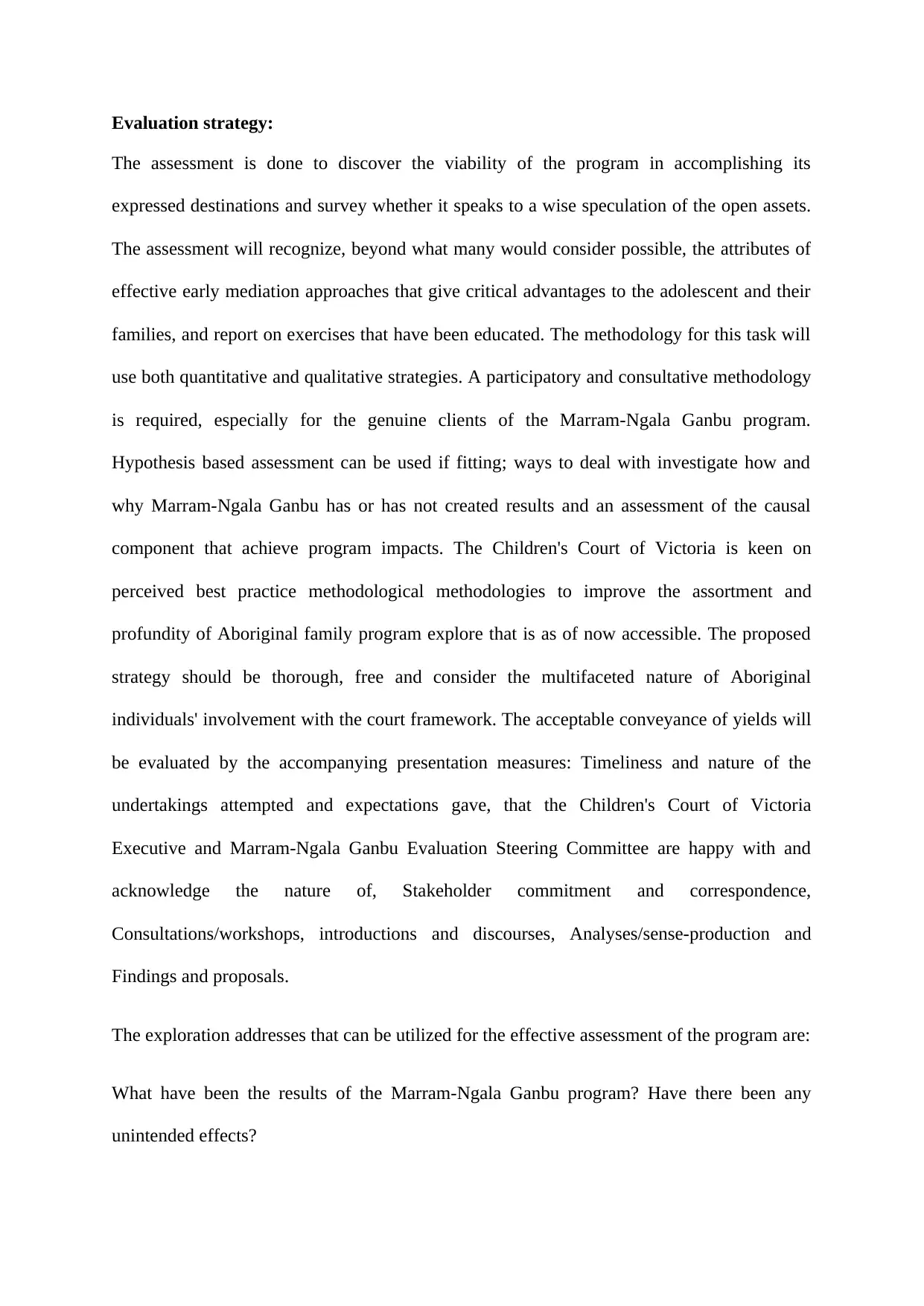
Evaluation strategy:
The assessment is done to discover the viability of the program in accomplishing its
expressed destinations and survey whether it speaks to a wise speculation of the open assets.
The assessment will recognize, beyond what many would consider possible, the attributes of
effective early mediation approaches that give critical advantages to the adolescent and their
families, and report on exercises that have been educated. The methodology for this task will
use both quantitative and qualitative strategies. A participatory and consultative methodology
is required, especially for the genuine clients of the Marram-Ngala Ganbu program.
Hypothesis based assessment can be used if fitting; ways to deal with investigate how and
why Marram-Ngala Ganbu has or has not created results and an assessment of the causal
component that achieve program impacts. The Children's Court of Victoria is keen on
perceived best practice methodological methodologies to improve the assortment and
profundity of Aboriginal family program explore that is as of now accessible. The proposed
strategy should be thorough, free and consider the multifaceted nature of Aboriginal
individuals' involvement with the court framework. The acceptable conveyance of yields will
be evaluated by the accompanying presentation measures: Timeliness and nature of the
undertakings attempted and expectations gave, that the Children's Court of Victoria
Executive and Marram-Ngala Ganbu Evaluation Steering Committee are happy with and
acknowledge the nature of, Stakeholder commitment and correspondence,
Consultations/workshops, introductions and discourses, Analyses/sense-production and
Findings and proposals.
The exploration addresses that can be utilized for the effective assessment of the program are:
What have been the results of the Marram-Ngala Ganbu program? Have there been any
unintended effects?
The assessment is done to discover the viability of the program in accomplishing its
expressed destinations and survey whether it speaks to a wise speculation of the open assets.
The assessment will recognize, beyond what many would consider possible, the attributes of
effective early mediation approaches that give critical advantages to the adolescent and their
families, and report on exercises that have been educated. The methodology for this task will
use both quantitative and qualitative strategies. A participatory and consultative methodology
is required, especially for the genuine clients of the Marram-Ngala Ganbu program.
Hypothesis based assessment can be used if fitting; ways to deal with investigate how and
why Marram-Ngala Ganbu has or has not created results and an assessment of the causal
component that achieve program impacts. The Children's Court of Victoria is keen on
perceived best practice methodological methodologies to improve the assortment and
profundity of Aboriginal family program explore that is as of now accessible. The proposed
strategy should be thorough, free and consider the multifaceted nature of Aboriginal
individuals' involvement with the court framework. The acceptable conveyance of yields will
be evaluated by the accompanying presentation measures: Timeliness and nature of the
undertakings attempted and expectations gave, that the Children's Court of Victoria
Executive and Marram-Ngala Ganbu Evaluation Steering Committee are happy with and
acknowledge the nature of, Stakeholder commitment and correspondence,
Consultations/workshops, introductions and discourses, Analyses/sense-production and
Findings and proposals.
The exploration addresses that can be utilized for the effective assessment of the program are:
What have been the results of the Marram-Ngala Ganbu program? Have there been any
unintended effects?
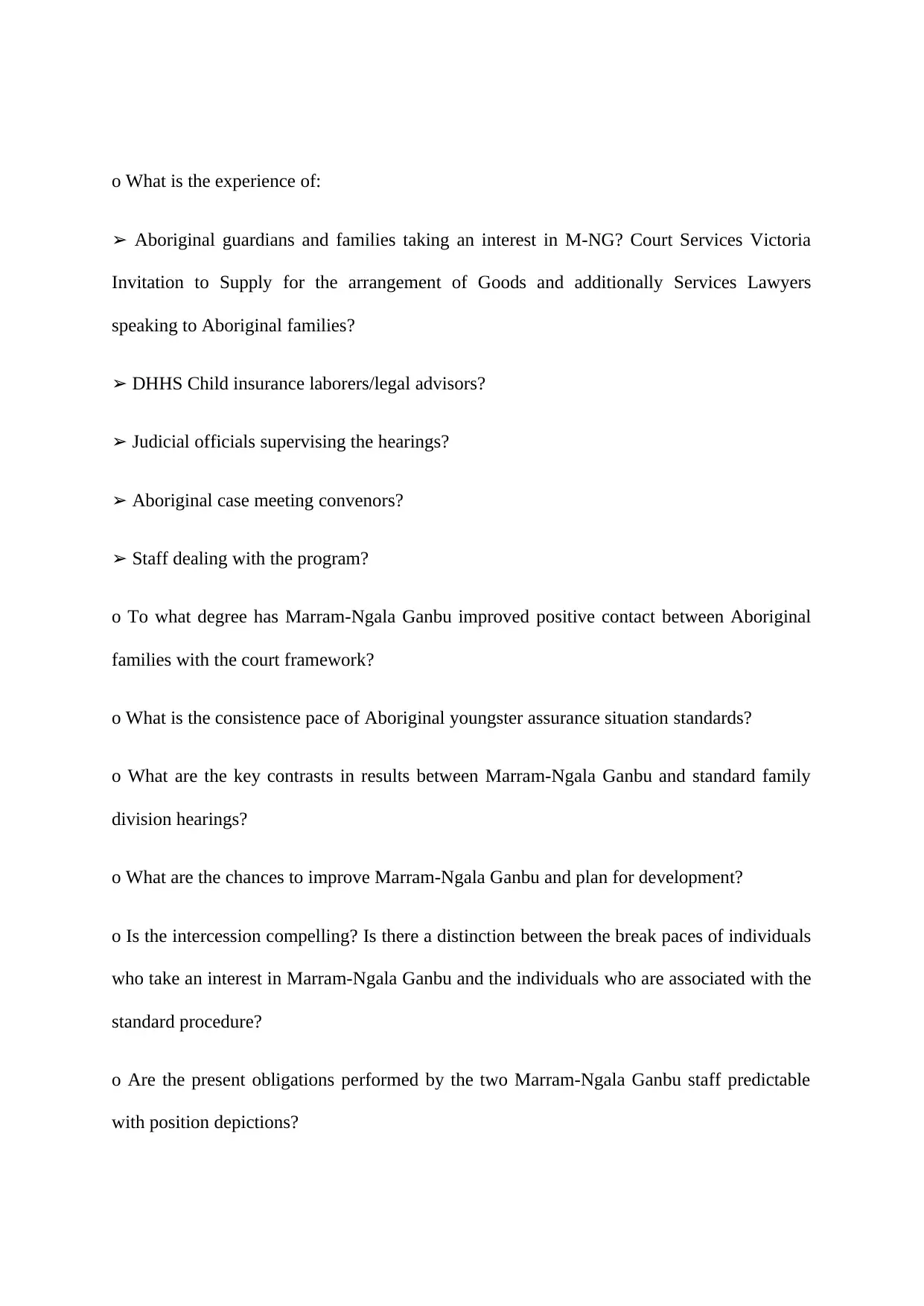
o What is the experience of:
➢ Aboriginal guardians and families taking an interest in M-NG? Court Services Victoria
Invitation to Supply for the arrangement of Goods and additionally Services Lawyers
speaking to Aboriginal families?
➢ DHHS Child insurance laborers/legal advisors?
➢ Judicial officials supervising the hearings?
➢ Aboriginal case meeting convenors?
➢ Staff dealing with the program?
o To what degree has Marram-Ngala Ganbu improved positive contact between Aboriginal
families with the court framework?
o What is the consistence pace of Aboriginal youngster assurance situation standards?
o What are the key contrasts in results between Marram-Ngala Ganbu and standard family
division hearings?
o What are the chances to improve Marram-Ngala Ganbu and plan for development?
o Is the intercession compelling? Is there a distinction between the break paces of individuals
who take an interest in Marram-Ngala Ganbu and the individuals who are associated with the
standard procedure?
o Are the present obligations performed by the two Marram-Ngala Ganbu staff predictable
with position depictions?
➢ Aboriginal guardians and families taking an interest in M-NG? Court Services Victoria
Invitation to Supply for the arrangement of Goods and additionally Services Lawyers
speaking to Aboriginal families?
➢ DHHS Child insurance laborers/legal advisors?
➢ Judicial officials supervising the hearings?
➢ Aboriginal case meeting convenors?
➢ Staff dealing with the program?
o To what degree has Marram-Ngala Ganbu improved positive contact between Aboriginal
families with the court framework?
o What is the consistence pace of Aboriginal youngster assurance situation standards?
o What are the key contrasts in results between Marram-Ngala Ganbu and standard family
division hearings?
o What are the chances to improve Marram-Ngala Ganbu and plan for development?
o Is the intercession compelling? Is there a distinction between the break paces of individuals
who take an interest in Marram-Ngala Ganbu and the individuals who are associated with the
standard procedure?
o Are the present obligations performed by the two Marram-Ngala Ganbu staff predictable
with position depictions?
⊘ This is a preview!⊘
Do you want full access?
Subscribe today to unlock all pages.

Trusted by 1+ million students worldwide
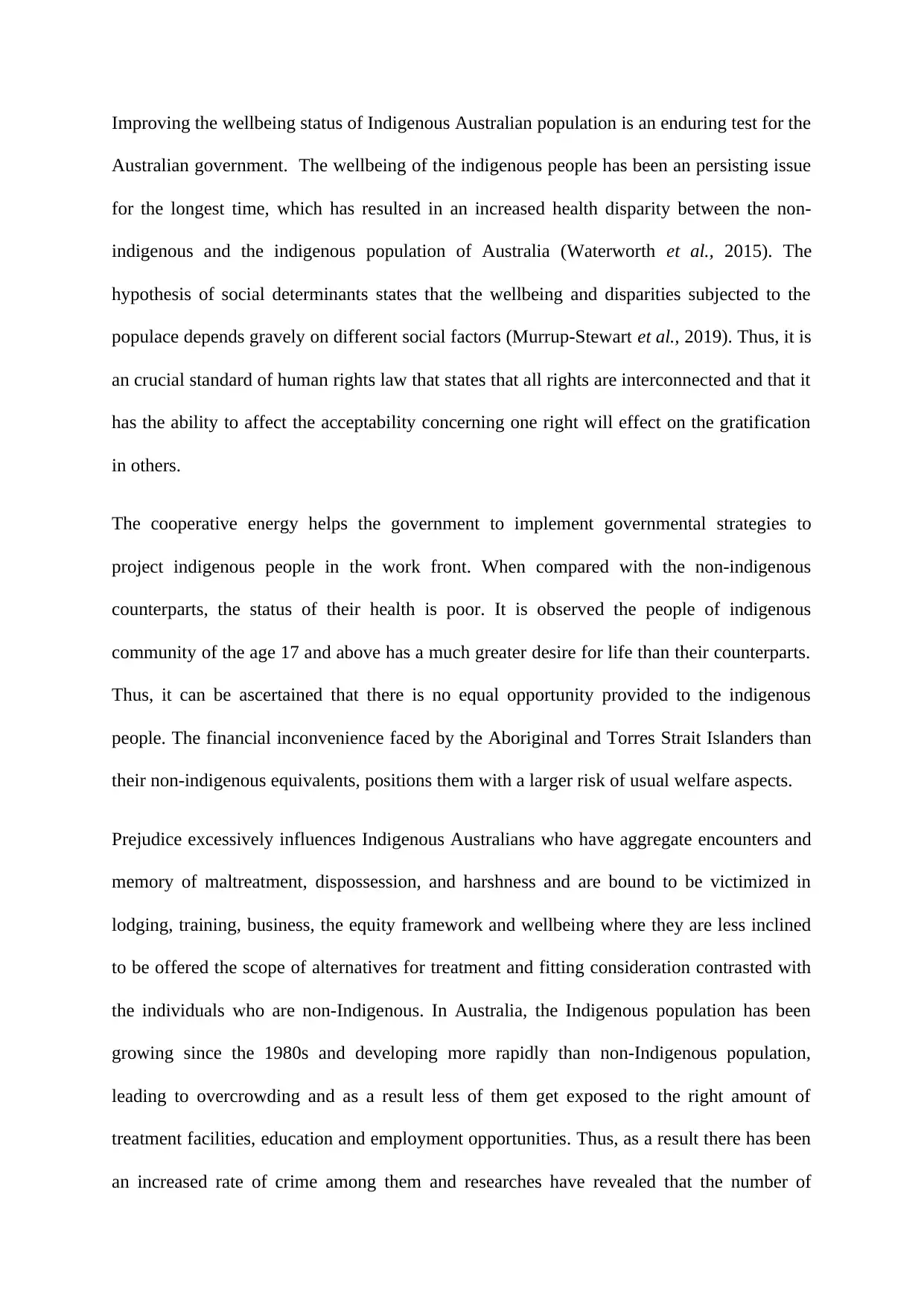
Improving the wellbeing status of Indigenous Australian population is an enduring test for the
Australian government. The wellbeing of the indigenous people has been an persisting issue
for the longest time, which has resulted in an increased health disparity between the non-
indigenous and the indigenous population of Australia (Waterworth et al., 2015). The
hypothesis of social determinants states that the wellbeing and disparities subjected to the
populace depends gravely on different social factors (Murrup‐Stewart et al., 2019). Thus, it is
an crucial standard of human rights law that states that all rights are interconnected and that it
has the ability to affect the acceptability concerning one right will effect on the gratification
in others.
The cooperative energy helps the government to implement governmental strategies to
project indigenous people in the work front. When compared with the non-indigenous
counterparts, the status of their health is poor. It is observed the people of indigenous
community of the age 17 and above has a much greater desire for life than their counterparts.
Thus, it can be ascertained that there is no equal opportunity provided to the indigenous
people. The financial inconvenience faced by the Aboriginal and Torres Strait Islanders than
their non-indigenous equivalents, positions them with a larger risk of usual welfare aspects.
Prejudice excessively influences Indigenous Australians who have aggregate encounters and
memory of maltreatment, dispossession, and harshness and are bound to be victimized in
lodging, training, business, the equity framework and wellbeing where they are less inclined
to be offered the scope of alternatives for treatment and fitting consideration contrasted with
the individuals who are non-Indigenous. In Australia, the Indigenous population has been
growing since the 1980s and developing more rapidly than non-Indigenous population,
leading to overcrowding and as a result less of them get exposed to the right amount of
treatment facilities, education and employment opportunities. Thus, as a result there has been
an increased rate of crime among them and researches have revealed that the number of
Australian government. The wellbeing of the indigenous people has been an persisting issue
for the longest time, which has resulted in an increased health disparity between the non-
indigenous and the indigenous population of Australia (Waterworth et al., 2015). The
hypothesis of social determinants states that the wellbeing and disparities subjected to the
populace depends gravely on different social factors (Murrup‐Stewart et al., 2019). Thus, it is
an crucial standard of human rights law that states that all rights are interconnected and that it
has the ability to affect the acceptability concerning one right will effect on the gratification
in others.
The cooperative energy helps the government to implement governmental strategies to
project indigenous people in the work front. When compared with the non-indigenous
counterparts, the status of their health is poor. It is observed the people of indigenous
community of the age 17 and above has a much greater desire for life than their counterparts.
Thus, it can be ascertained that there is no equal opportunity provided to the indigenous
people. The financial inconvenience faced by the Aboriginal and Torres Strait Islanders than
their non-indigenous equivalents, positions them with a larger risk of usual welfare aspects.
Prejudice excessively influences Indigenous Australians who have aggregate encounters and
memory of maltreatment, dispossession, and harshness and are bound to be victimized in
lodging, training, business, the equity framework and wellbeing where they are less inclined
to be offered the scope of alternatives for treatment and fitting consideration contrasted with
the individuals who are non-Indigenous. In Australia, the Indigenous population has been
growing since the 1980s and developing more rapidly than non-Indigenous population,
leading to overcrowding and as a result less of them get exposed to the right amount of
treatment facilities, education and employment opportunities. Thus, as a result there has been
an increased rate of crime among them and researches have revealed that the number of
Paraphrase This Document
Need a fresh take? Get an instant paraphrase of this document with our AI Paraphraser
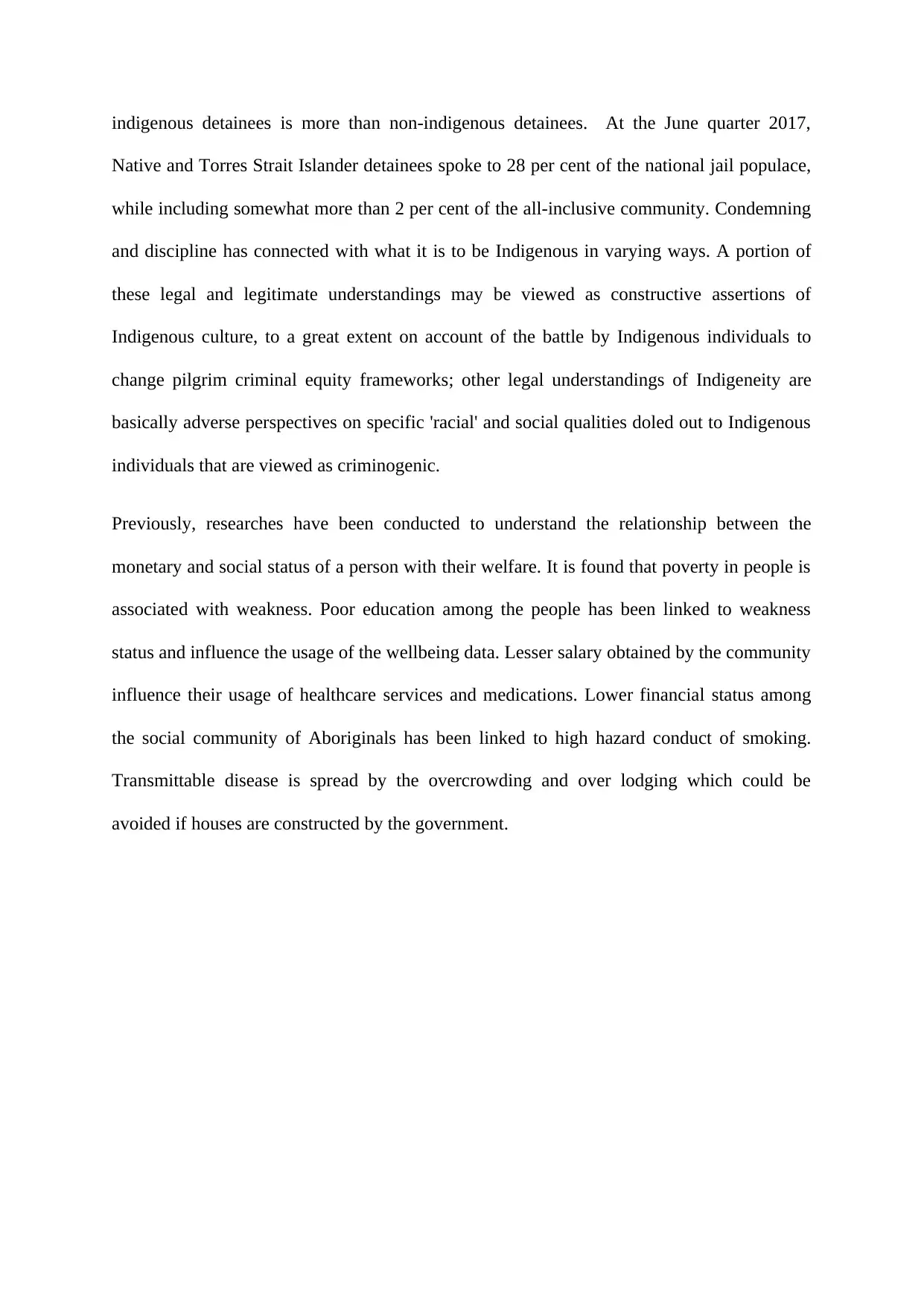
indigenous detainees is more than non-indigenous detainees. At the June quarter 2017,
Native and Torres Strait Islander detainees spoke to 28 per cent of the national jail populace,
while including somewhat more than 2 per cent of the all-inclusive community. Condemning
and discipline has connected with what it is to be Indigenous in varying ways. A portion of
these legal and legitimate understandings may be viewed as constructive assertions of
Indigenous culture, to a great extent on account of the battle by Indigenous individuals to
change pilgrim criminal equity frameworks; other legal understandings of Indigeneity are
basically adverse perspectives on specific 'racial' and social qualities doled out to Indigenous
individuals that are viewed as criminogenic.
Previously, researches have been conducted to understand the relationship between the
monetary and social status of a person with their welfare. It is found that poverty in people is
associated with weakness. Poor education among the people has been linked to weakness
status and influence the usage of the wellbeing data. Lesser salary obtained by the community
influence their usage of healthcare services and medications. Lower financial status among
the social community of Aboriginals has been linked to high hazard conduct of smoking.
Transmittable disease is spread by the overcrowding and over lodging which could be
avoided if houses are constructed by the government.
Native and Torres Strait Islander detainees spoke to 28 per cent of the national jail populace,
while including somewhat more than 2 per cent of the all-inclusive community. Condemning
and discipline has connected with what it is to be Indigenous in varying ways. A portion of
these legal and legitimate understandings may be viewed as constructive assertions of
Indigenous culture, to a great extent on account of the battle by Indigenous individuals to
change pilgrim criminal equity frameworks; other legal understandings of Indigeneity are
basically adverse perspectives on specific 'racial' and social qualities doled out to Indigenous
individuals that are viewed as criminogenic.
Previously, researches have been conducted to understand the relationship between the
monetary and social status of a person with their welfare. It is found that poverty in people is
associated with weakness. Poor education among the people has been linked to weakness
status and influence the usage of the wellbeing data. Lesser salary obtained by the community
influence their usage of healthcare services and medications. Lower financial status among
the social community of Aboriginals has been linked to high hazard conduct of smoking.
Transmittable disease is spread by the overcrowding and over lodging which could be
avoided if houses are constructed by the government.
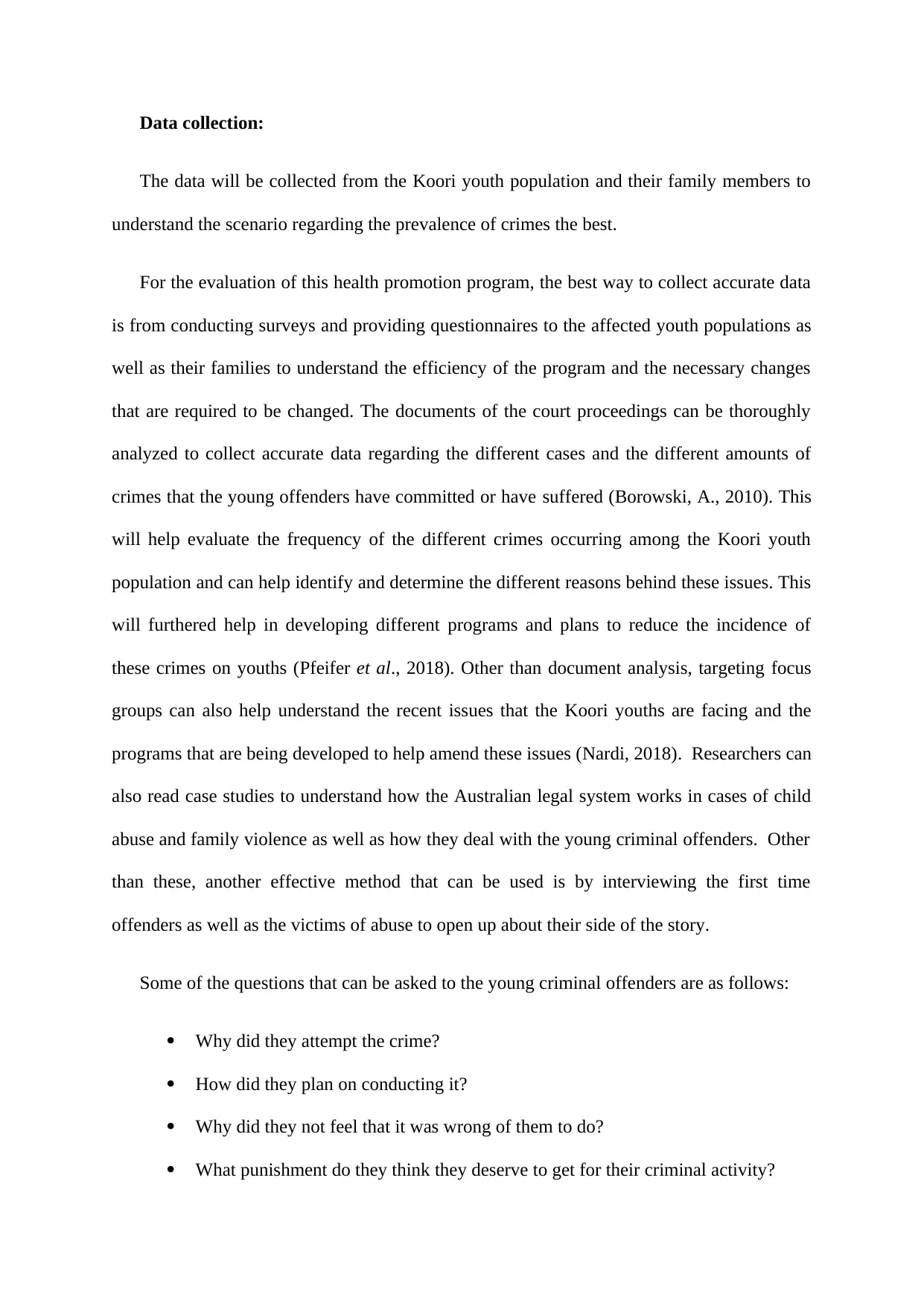
Data collection:
The data will be collected from the Koori youth population and their family members to
understand the scenario regarding the prevalence of crimes the best.
For the evaluation of this health promotion program, the best way to collect accurate data
is from conducting surveys and providing questionnaires to the affected youth populations as
well as their families to understand the efficiency of the program and the necessary changes
that are required to be changed. The documents of the court proceedings can be thoroughly
analyzed to collect accurate data regarding the different cases and the different amounts of
crimes that the young offenders have committed or have suffered (Borowski, A., 2010). This
will help evaluate the frequency of the different crimes occurring among the Koori youth
population and can help identify and determine the different reasons behind these issues. This
will furthered help in developing different programs and plans to reduce the incidence of
these crimes on youths (Pfeifer et al., 2018). Other than document analysis, targeting focus
groups can also help understand the recent issues that the Koori youths are facing and the
programs that are being developed to help amend these issues (Nardi, 2018). Researchers can
also read case studies to understand how the Australian legal system works in cases of child
abuse and family violence as well as how they deal with the young criminal offenders. Other
than these, another effective method that can be used is by interviewing the first time
offenders as well as the victims of abuse to open up about their side of the story.
Some of the questions that can be asked to the young criminal offenders are as follows:
Why did they attempt the crime?
How did they plan on conducting it?
Why did they not feel that it was wrong of them to do?
What punishment do they think they deserve to get for their criminal activity?
The data will be collected from the Koori youth population and their family members to
understand the scenario regarding the prevalence of crimes the best.
For the evaluation of this health promotion program, the best way to collect accurate data
is from conducting surveys and providing questionnaires to the affected youth populations as
well as their families to understand the efficiency of the program and the necessary changes
that are required to be changed. The documents of the court proceedings can be thoroughly
analyzed to collect accurate data regarding the different cases and the different amounts of
crimes that the young offenders have committed or have suffered (Borowski, A., 2010). This
will help evaluate the frequency of the different crimes occurring among the Koori youth
population and can help identify and determine the different reasons behind these issues. This
will furthered help in developing different programs and plans to reduce the incidence of
these crimes on youths (Pfeifer et al., 2018). Other than document analysis, targeting focus
groups can also help understand the recent issues that the Koori youths are facing and the
programs that are being developed to help amend these issues (Nardi, 2018). Researchers can
also read case studies to understand how the Australian legal system works in cases of child
abuse and family violence as well as how they deal with the young criminal offenders. Other
than these, another effective method that can be used is by interviewing the first time
offenders as well as the victims of abuse to open up about their side of the story.
Some of the questions that can be asked to the young criminal offenders are as follows:
Why did they attempt the crime?
How did they plan on conducting it?
Why did they not feel that it was wrong of them to do?
What punishment do they think they deserve to get for their criminal activity?
⊘ This is a preview!⊘
Do you want full access?
Subscribe today to unlock all pages.

Trusted by 1+ million students worldwide
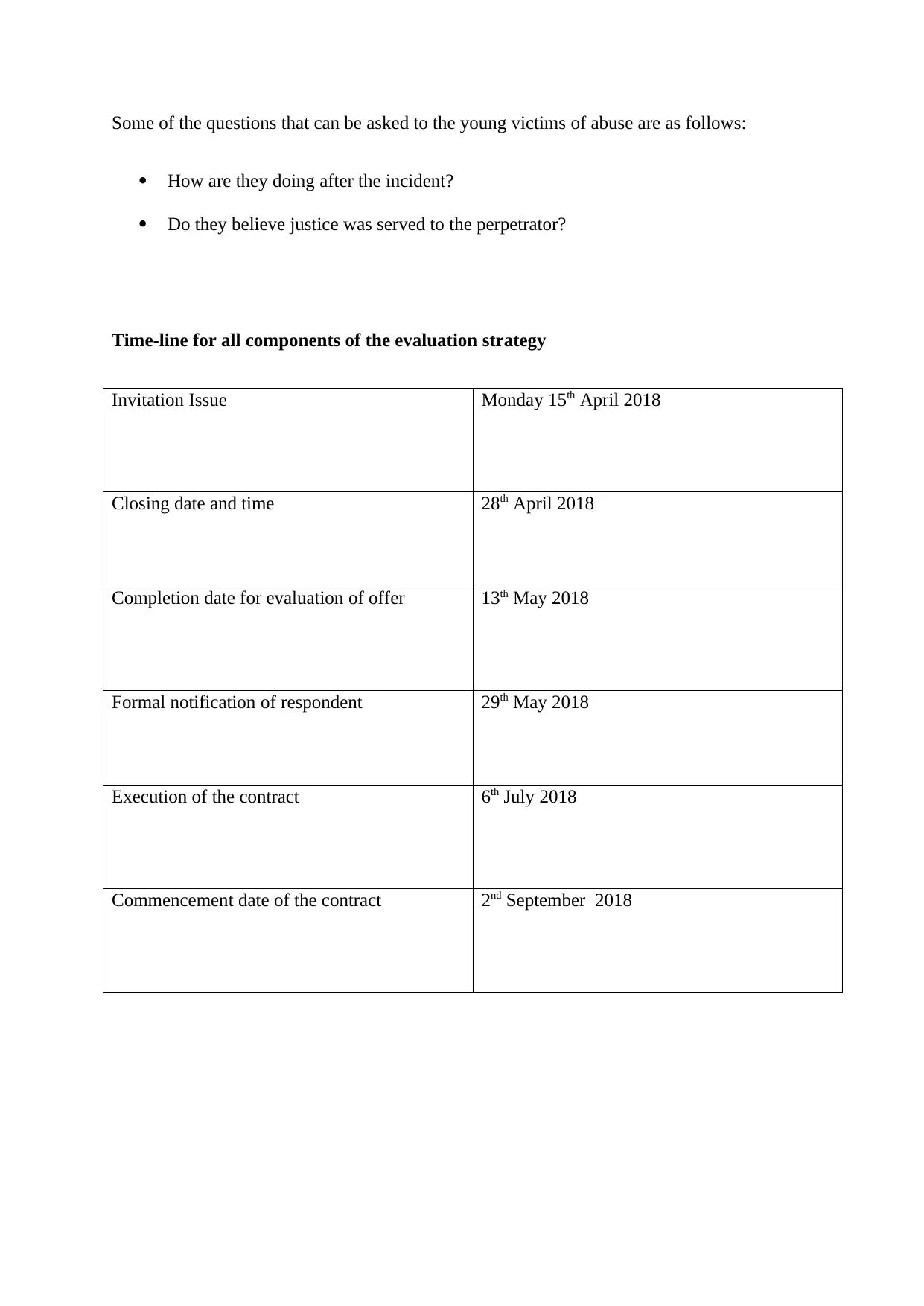
Some of the questions that can be asked to the young victims of abuse are as follows:
How are they doing after the incident?
Do they believe justice was served to the perpetrator?
Time-line for all components of the evaluation strategy
Invitation Issue Monday 15th April 2018
Closing date and time 28th April 2018
Completion date for evaluation of offer 13th May 2018
Formal notification of respondent 29th May 2018
Execution of the contract 6th July 2018
Commencement date of the contract 2nd September 2018
How are they doing after the incident?
Do they believe justice was served to the perpetrator?
Time-line for all components of the evaluation strategy
Invitation Issue Monday 15th April 2018
Closing date and time 28th April 2018
Completion date for evaluation of offer 13th May 2018
Formal notification of respondent 29th May 2018
Execution of the contract 6th July 2018
Commencement date of the contract 2nd September 2018
Paraphrase This Document
Need a fresh take? Get an instant paraphrase of this document with our AI Paraphraser
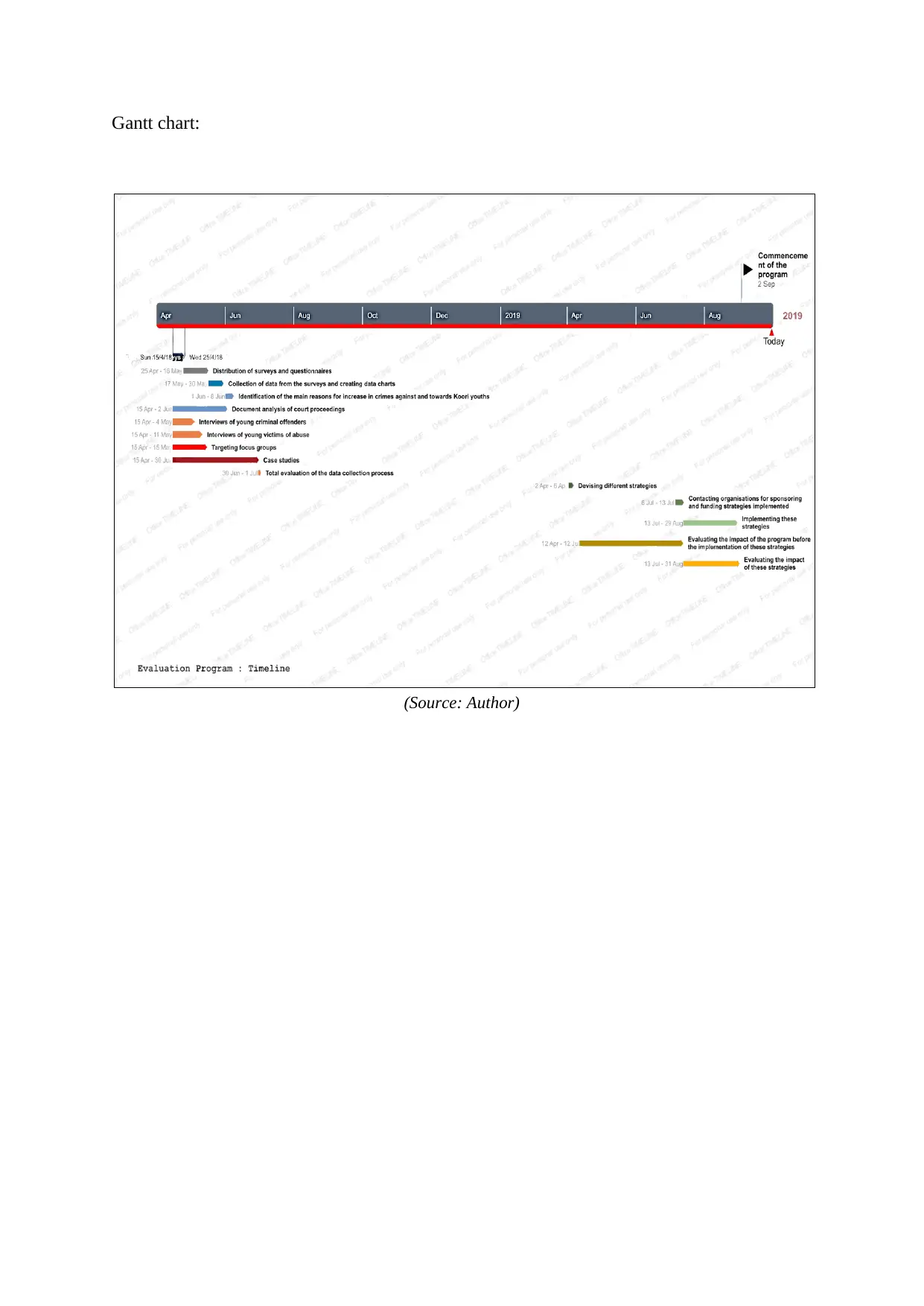
Gantt chart:
(Source: Author)
(Source: Author)
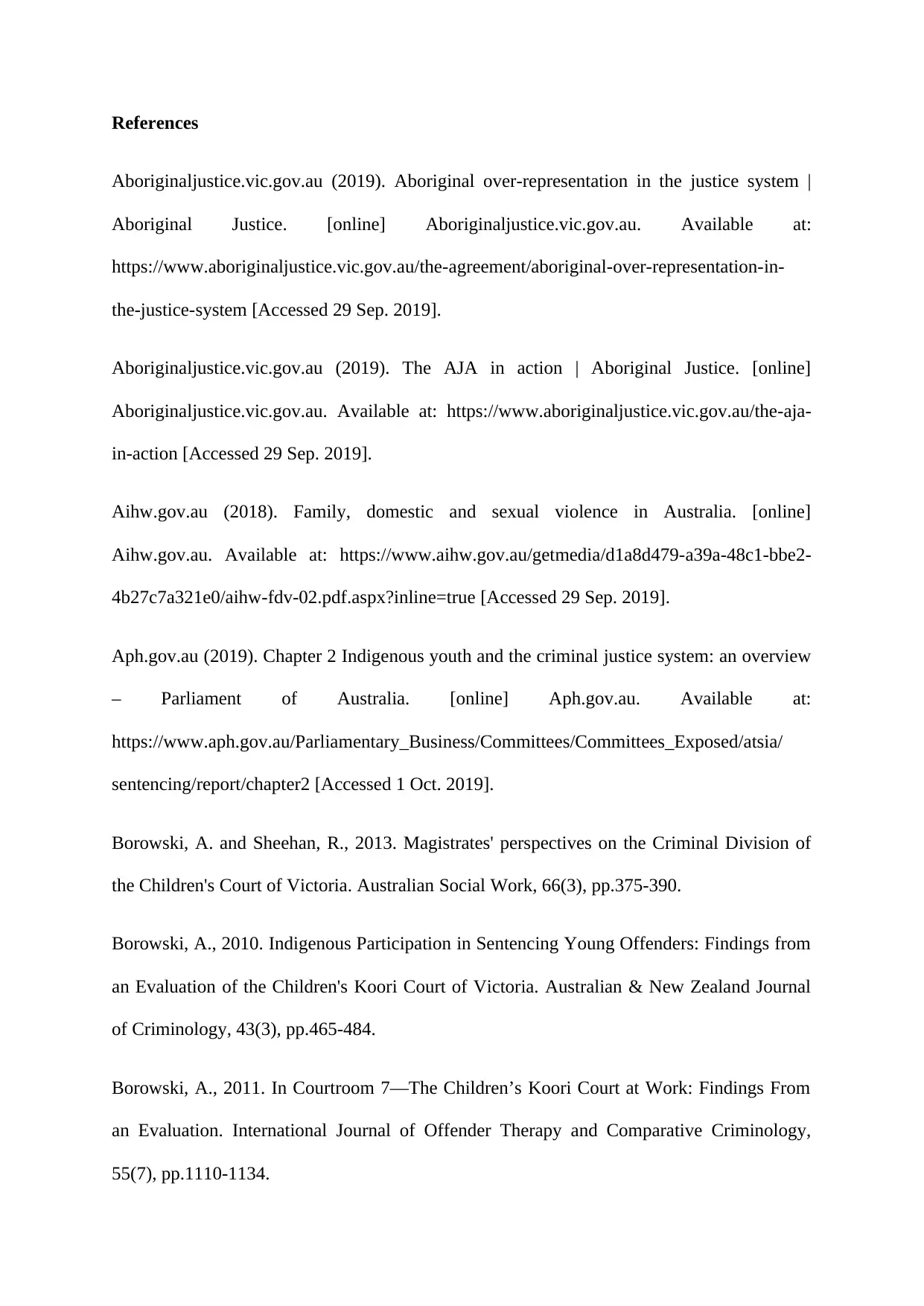
References
Aboriginaljustice.vic.gov.au (2019). Aboriginal over-representation in the justice system |
Aboriginal Justice. [online] Aboriginaljustice.vic.gov.au. Available at:
https://www.aboriginaljustice.vic.gov.au/the-agreement/aboriginal-over-representation-in-
the-justice-system [Accessed 29 Sep. 2019].
Aboriginaljustice.vic.gov.au (2019). The AJA in action | Aboriginal Justice. [online]
Aboriginaljustice.vic.gov.au. Available at: https://www.aboriginaljustice.vic.gov.au/the-aja-
in-action [Accessed 29 Sep. 2019].
Aihw.gov.au (2018). Family, domestic and sexual violence in Australia. [online]
Aihw.gov.au. Available at: https://www.aihw.gov.au/getmedia/d1a8d479-a39a-48c1-bbe2-
4b27c7a321e0/aihw-fdv-02.pdf.aspx?inline=true [Accessed 29 Sep. 2019].
Aph.gov.au (2019). Chapter 2 Indigenous youth and the criminal justice system: an overview
– Parliament of Australia. [online] Aph.gov.au. Available at:
https://www.aph.gov.au/Parliamentary_Business/Committees/Committees_Exposed/atsia/
sentencing/report/chapter2 [Accessed 1 Oct. 2019].
Borowski, A. and Sheehan, R., 2013. Magistrates' perspectives on the Criminal Division of
the Children's Court of Victoria. Australian Social Work, 66(3), pp.375-390.
Borowski, A., 2010. Indigenous Participation in Sentencing Young Offenders: Findings from
an Evaluation of the Children's Koori Court of Victoria. Australian & New Zealand Journal
of Criminology, 43(3), pp.465-484.
Borowski, A., 2011. In Courtroom 7—The Children’s Koori Court at Work: Findings From
an Evaluation. International Journal of Offender Therapy and Comparative Criminology,
55(7), pp.1110-1134.
Aboriginaljustice.vic.gov.au (2019). Aboriginal over-representation in the justice system |
Aboriginal Justice. [online] Aboriginaljustice.vic.gov.au. Available at:
https://www.aboriginaljustice.vic.gov.au/the-agreement/aboriginal-over-representation-in-
the-justice-system [Accessed 29 Sep. 2019].
Aboriginaljustice.vic.gov.au (2019). The AJA in action | Aboriginal Justice. [online]
Aboriginaljustice.vic.gov.au. Available at: https://www.aboriginaljustice.vic.gov.au/the-aja-
in-action [Accessed 29 Sep. 2019].
Aihw.gov.au (2018). Family, domestic and sexual violence in Australia. [online]
Aihw.gov.au. Available at: https://www.aihw.gov.au/getmedia/d1a8d479-a39a-48c1-bbe2-
4b27c7a321e0/aihw-fdv-02.pdf.aspx?inline=true [Accessed 29 Sep. 2019].
Aph.gov.au (2019). Chapter 2 Indigenous youth and the criminal justice system: an overview
– Parliament of Australia. [online] Aph.gov.au. Available at:
https://www.aph.gov.au/Parliamentary_Business/Committees/Committees_Exposed/atsia/
sentencing/report/chapter2 [Accessed 1 Oct. 2019].
Borowski, A. and Sheehan, R., 2013. Magistrates' perspectives on the Criminal Division of
the Children's Court of Victoria. Australian Social Work, 66(3), pp.375-390.
Borowski, A., 2010. Indigenous Participation in Sentencing Young Offenders: Findings from
an Evaluation of the Children's Koori Court of Victoria. Australian & New Zealand Journal
of Criminology, 43(3), pp.465-484.
Borowski, A., 2011. In Courtroom 7—The Children’s Koori Court at Work: Findings From
an Evaluation. International Journal of Offender Therapy and Comparative Criminology,
55(7), pp.1110-1134.
⊘ This is a preview!⊘
Do you want full access?
Subscribe today to unlock all pages.

Trusted by 1+ million students worldwide
1 out of 14
Related Documents
Your All-in-One AI-Powered Toolkit for Academic Success.
+13062052269
info@desklib.com
Available 24*7 on WhatsApp / Email
![[object Object]](/_next/static/media/star-bottom.7253800d.svg)
Unlock your academic potential
Copyright © 2020–2025 A2Z Services. All Rights Reserved. Developed and managed by ZUCOL.





